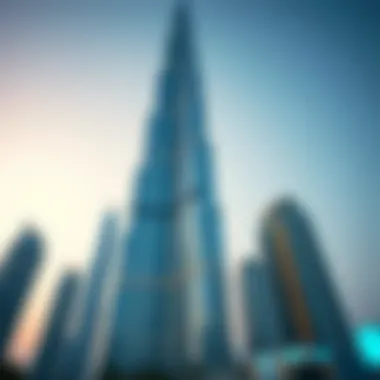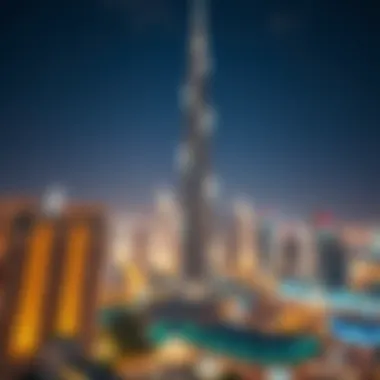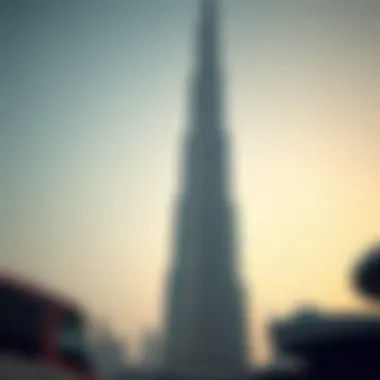Burj Khalifa: A Deep Dive into Its Residential and Commercial Aspects


Intro
The Burj Khalifa stands not merely as a feat of engineering but as a vivid emblem of luxury, lifestyle, and commerce in Dubai. This towering giant reshapes the skyline and redefines what is possible in both residential living and commercial endeavors. At its core, the building reflects an intricate blend of multiple functionalities, making it a case study that many investors, homebuyers, and professionals can learn from.
In this exploration, we unpack the dual aspects of the Burj Khalifa, delving into the architectural innovations, market trends, and investment opportunities it presents. With Dubai’s real estate landscape evolving rapidly, understanding the opportunities and challenges associated with this iconic structure holds significant relevance for potential stakeholders.
Market Trends and Insights
Current Market Overview
As of now, the Burj Khalifa has transformed the property landscape in Dubai. The demand for residential spaces remains robust, thanks to the allure of living in the world’s tallest building. Prices in this exclusive market segment often reflect the prestige associated with the Burj, keeping investor interest lively.
- Residential occupancy rates: High, with a unique appeal among affluent individuals and expatriates.
- Commercial space utilization: Strong, attracting global companies looking for a prestigious address.
- Market segmentation: A distinct blend of high-end residential apartments and premium office spaces segregates the building's offerings.
Future Projections and Opportunities
Looking to the future, the Burj Khalifa is likely to continue being a focal point in Dubai’s real estate sector. The rise of smart technology and sustainable practices in construction could further enhance its standing as a desirable investment. Factors compelling investors include:
- Increased tourism: With travel returning post-pandemic, international tourism supports demand for both residential and commercial spaces.
- Developments in the surrounding area: New infrastructure projects and urban developments are poised to increase the value of properties around the Burj Khalifa.
- Long-term investment benefits: Buyers eyeing long-term foresight may find potential in the increasing desirability of prime locations.
"Investing in iconic structures like the Burj Khalifa not only offers immediate benefits but a legacy of value that stands the test of time." - Real Estate Expert
Buying and Selling Strategies
Key Considerations for Buyers
Investing in property at the Burj Khalifa isn’t merely about the purchase; it's about recognizing the unique aspects that make it stand out. Potential buyers should consider:
- Location and Lifestyle: Living or working here provides unparalleled access to amenities and scenic views.
- Cost versus Value: While initial costs are significant, assess the long-term return on investment.
- Market Timing: Understanding market trends could provide leverage during negotiations.
Effective Selling Techniques
For those looking to sell, articulating the distinct value proposition of the Burj Khalifa is key. Considerations include:
- Highlighting the Unique Features: Emphasize luxury amenities, building history, and renowned architectural design in listings.
- Leveraging Social Proof: Utilize testimonials from satisfied residents or businesses to build credibility.
- Targeted Marketing: Focus on luxury publications and platforms that cater to high-net-worth individuals.
As the landscape evolves, the Burj Khalifa stands as both a landmark and a nexus of opportunity for those involved in real estate. Its intricate balance of commercial and residential spaces serves as a fascinating case for analysis and investment.
Overview of the Burj Khalifa
The Burj Khalifa is not just an architectural marvel; it embodies a paradigm shift in urban development. As the tallest structure in the world, standing at a staggering 828 meters, it establishes a new benchmark for skyscrapers globally. The significance of analyzing the Burj Khalifa lies in its dual-functionality—residential and commercial spaces harmoniously interwoven. This examination reveals not only the potential for investment but also the broader economic and social impacts felt throughout Dubai and beyond.
Through its design and offerings, the Burj Khalifa serves as a microcosm of the modern city—the interplay of luxury living and high-powered business in one iconic location. Investors and stakeholders alike must recognize the monumental influence this edifice wields over real estate trends, consumer behavior, and urban planning.
Historical Context
The Burj Khalifa's story began with a vision to redefine Dubai as a global city in the early 2000s. Developed by Emaar Properties, construction commenced in 2004 and finished in 2010, with its official opening celebrated on January 4th, coinciding with the United Arab Emirates' national day. The building was designed by Adrian Smith of Skidmore, Owings & Merrill, taking inspiration from Islamic architecture while incorporating cutting-edge engineering techniques.
Over the years, this towering skyscraper has not only become a symbol of national pride but also a significant attraction for tourists worldwide. Each year, millions flock to view its breathtaking design and experience its observation decks, making it a linchpin in Dubai's hospitality and tourism strategies. The Burj Khalifa's history is a testament to ambition and blending diverse cultural influences under the expansive desert sky.
Architectural Significance
The architectural brilliance of the Burj Khalifa extends beyond its mere height. The structure features a unique triple-lobed footprint derived from the Hymenocallis flower. This design is not only aesthetically pleasing but also strategically functional, contributing to its stability and resilience against wind forces. The building's structure utilizes a reinforced concrete core, surrounded by a series of setbacks that taper gracefully as it ascends.


Moreover, the intricate facade composed of reflective glazing and textured concrete elements further enhances the building's visual allure, mirroring the shifting colors of the sun. High-performance insulation reduces energy consumption, showcasing how the structure marries sustainability with luxury living. This balance of form and functionality truly captivates the observer and raises the bar for future skyscraper designs.
"The Burj Khalifa is not just a building; it is a beacon of possibility in urban design, growth, and sustainable living."
For thoughtful insights on its impact, further exploration can be done via resources like Wikipedia and Britannica. This iconic structure indeed lends itself to many narratives that extend beyond brick and mortar.
Residential Component of the Burj Khalifa
The residential part of the Burj Khalifa isn't just an afterthought; it plays a crucial role in the building's identity, showcasing a lifestyle that's both luxurious and innovative. As the tallest structure in the world, this iconic tower isn't merely about height; it's about what that height can offer to those who call it home. The blend of residential and commercial uses here paints a vivid picture of modern living, highlighting how a space can cater to both peace and productivity.
Residential Units: An Overview
The Burj Khalifa houses around 900 private residences, which include one, two, three, and four-bedroom apartments. Each unit is designed to maximize views of the sprawling city below and beyond. Imagine living high above the hustle and bustle of Dubai, where the view from your window is nothing short of breathtaking. The layout emphasizes openness and natural light, with floor-to-ceiling windows being a standard feature, allowing the rays of the Arabian sun to flood in.
Hang on to your hats, because living here does not come without a hefty price tag. Ownership here is a statement of success, embedding residents into the fabric of Dubai’s elite social fabric. The interiors, crafted with the finest materials, feature luxurious finishes and state-of-the-art appliances.
"The lifestyle here often embodies a synergy of comfort and luxury— a space designed not just for living, but for thriving."
Amenities and Features
In keeping with its stature, the Burj Khalifa offers a plethora of amenities geared towards enhancing the living experience. These include:
- Health and Wellness Facilities: Residents enjoy access to a tranquil spa and well-equipped fitness centers. There’s even a swimming pool that allows leisure while soaking in stunning aerial vistas.
- Concierge Services: Consider the convenience of having a concierge at your beck and call. This adds a touch of personalized luxury to everyday tasks.
- Social Spaces: Designed to foster community, the building includes lounges and events spaces where residents can gather and socialize.
- Safety and Security: State-of-the-art security systems ensure residents feel safe in their refined cocoon, allowing them to enjoy an exclusive lifestyle without constant worry.
Market Demand and Pricing
The demand for residential units in the Burj Khalifa remains consistently high. This is largely due to a unique combination of exclusivity, prestige, and the allure of living in an architectural marvel. Generally, buying a unit here means not just acquiring a home, but also a valuable asset that appreciates over time.
Pricing varies significantly, influenced by size, views, and floor level. As of recent data, prices can range from approximately 1.5 million to upwards of 18 million AED, making it not only a living space but an investment opportunity as well. The luxury residential market in Dubai continues to attract both investors and expatriates, ensuring that the demand for such coveted living spaces does not dwindle soon.
To further detail the nuances of the residential component:
- Stability in Value: The Burj Khalifa's prestige means property values in the building often remain resilient, even during market fluctuations.
- Attractiveness to Investors: International buyers often eye units here for both personal use and as part of investment portfolios, seeking the dual benefits of lifestyle and financial return.
- Lifestyle Appeal: The comprehensive amenities and the iconic status of the Burj Khalifa draw in residents who desire a luxurious lifestyle without compromising on comfort and convenience.
The Burj Khalifa distinctly captures a significant essence of modern residential living, harmonizing luxury and practicality in a city built on grandeur.
Commercial Component of the Burj Khalifa
The Burj Khalifa serves not only as a striking symbol of human ingenuity but also as a significant hub for commercial activity in Dubai. This dual role is pivotal for understanding its overall impact on the city's economic and urban landscape. The commercial component encapsulates a mix of office spaces, retail outlets, and hospitality services, which together create a vibrant ecosystem that attracts both local and international businesses.
The benefits of having commercial spaces centralized in such a prominent building as the Burj Khalifa are manifold. These include the ability to draw in a diverse clientele, boost real estate values, and foster a sense of community among businesses. The building itself serves as a symbol of prestige, making it an appealing location for companies that wish to enhance their corporate image.
Establishing a commercial presence in the Burj Khalifa is not without its considerations though. Factors such as rental costs, competitive pressures, and tenant relations are all critical for sustaining a vibrant mix of businesses. Understanding these elements is crucial for stakeholders, investors, and tenants alike.
Commercial Spaces Available
Within the Burj Khalifa, commercial spaces are designed to cater to a variety of businesses from various sectors. The available spaces include:
- Office Units: Designed with modern amenities, these offices offer panoramic views of the city and state-of-the-art facilities, essential for high-level corporate functions.
- Retail Outlets: Located primarily on the lower levels, these shops range from luxury brands to casual retail. The foot traffic generated by both residents and visitors adds to their appeal.
- Hospitality Venues: With two high-end hotels situated within the structure, the Burj Khalifa also accommodates restaurants and lounges that contribute to its commercial vitality.
The mixture of these spaces creates a multifaceted commercial environment where businesses can thrive through collaboration and synergy.
Key Tenants and Businesses
The Burj Khalifa houses a variety of notable tenants that enhance its reputation as a business epicenter. Recognizable names such as Samsung Engineering, Ernst & Young, and The Public Investment Fund of Saudi Arabia occupy its office spaces. These businesses leverage the premium location, which provides them visibility and status. Retail spaces are often filled with luxury brands and unique dining experiences, creating a diverse consumer environment for residents and tourists alike.


By positioning themselves in such an iconic landmark, these tenants not only gain a vantage point in terms of customer engagement but also enjoy the associated prestige that comes from being part of the Burj Khalifa's unique story.
Economic Impact on Dubai
The commercial activities taking place within the Burj Khalifa significantly contribute to Dubai's economy. The presence of global brands and high-profile businesses helps to increase the city’s attractiveness as a destination for international investment. This influx of capital can be observed in several areas:
- Employment Opportunities: The diverse range of businesses creates job openings in various sectors—from hospitality staff to corporate professionals.
- Tourism Growth: As one of the tallest structures globally, the Burj Khalifa naturally draws tourists, which boosts demand for retail and dining experiences onsite.
- Increased Real Estate Value: The allure of a commercial presence at the Burj Khalifa has a ripple effect on surrounding real estate, improving property values in adjacent areas.
"The Burj Khalifa is not simply a building; it's a catalyst for economic activity that resonates throughout Dubai."
Comparative Analysis: Residential vs. Commercial
The Burj Khalifa stands not just as a feat of engineering, but also as a testament to the intricate blend of residential and commercial spaces. This duality is significant for various stakeholders including investors, urban planners, and potential tenants. By dissecting the components of both residential and commercial aspects within this iconic skyscraper, we can glean insights into market dynamics, risks, and opportunities that are unique to this mixed-use environment.
Investment Opportunities
When we talk about investment opportunities in the Burj Khalifa, the contrast between residential and commercial types is telling. Investors may find residential units appealing for their potential for steady income through rentals. However, the commercial spaces offer a different flavor of opportunity, often tied to the fluctuating demand of businesses looking for prime office space.
- Residential Investments:
- Commercial Investments:
- Steady rental yield due to high demand from affluent expatriates.
- Potential for long-term appreciation as Dubai continues its development.
- Leases are typically longer, providing stability for landlords.
- Demand from multinational corporations seeking prestigious locations prompts competitive prices.
Investors need to factor in these dimensions carefully when considering which avenue aligns with their investment goals. The choice between investing in a sleek apartment with a view or a bustling office space ultimately hinges on individual risk appetite and market conditions.
Return on Investment
Diving deeper into returns, it’s essential to compare the metrics surrounding both types of spaces. Residential properties in the Burj Khalifa often yield a return that is appealing to homeowners and landlords alike.
- Residential Returns: Typical rental yields for high-end properties in this segment hover around 6-8%, influenced by location and amenities.
- Commercial Returns: Conversely, commercial rentals can achieve higher yields, often exceeding 10%, contingent upon lease agreements and tenant quality.
A thorough understanding of these returns—be it from a condominium or an office suite—equips investors with the tools to make informed decisions, balancing risk with reward.
Target Demographics
The demographics occupying or pursuing space within the Burj Khalifa's residential versus commercial sections differ significantly. Understanding these target markets is key to shaping investment strategies.
- Residential Demographic:
- Commercial Demographic:
- Typically includes high-net-worth individuals, expatriates, and affluent locals seeking luxury living combined with unparalleled amenities.
- The residential units cater to a lifestyle choice, promoting exclusivity and status.
- This space attracts multinational enterprises, high-end retailers, and innovative startups looking for premium visibility and access.
- Firms often prioritize proximity to other businesses and resources, which the Burj Khalifa effortlessly provides.
In short, the distinctions between residents and commercial tenants are pronounced, impacting not just occupancy rates but also marketing strategies and investment considerations.
The amalgamation of these two aspects illustrates the Burj Khalifa's role as more than a building; it is an ecosystem that serves diverse needs and aspirations, making it a focal point in Dubai’s real estate narrative.
Challenges in Managing Mixed-Use Spaces
Managing a mixed-use structure like the Burj Khalifa isn't a walk in the park. The combination of residential and commercial elements brings its own set of challenges that need careful navigation. The stakes are high, as how well these spaces are managed can significantly impact the property’s reputation and, by extension, its value in the real estate market.
The importance of managing mixed-use spaces requires understanding the interplay between different tenant groups. On one hand, you have residents looking for comfort and security; on the other, businesses need operational efficiency. Balancing these needs is crucial for the overall success of the Burj Khalifa. Let's break down some specific challenges involved in handling such a complex environment.


Tenant Relations
Keeping the peace among residents and businesses is no small feat. The Burj Khalifa houses multiple stakeholders with differing needs. While residents enjoy their beautifully designed living spaces, businesses demand a high level of visibility and customer traffic. Issues like noise complaints from residential units due to late-night activities of commercial tenants or disagreements over shared resources can culminate in strained relations.
To address these concerns, property managers often establish clear communication channels. Regular meetings can help foster understanding among tenants, allowing them to voice concerns and seek resolutions collaboratively. Establishing policies that promote harmony, such as designating specific hours for operational activities, can also be beneficial.
Operational Costs
Mixed-use properties tend to incur unique operational costs. On the surface, splitting a building's functionality into residential and commercial might seem efficient, but dig a little deeper, and the complexities multiply. Maintenance costs can surge due to the wear and tear that different types of usage bring, especially in a high-traffic area like the Burj Khalifa.
Moreover, energy consumption patterns can differ widely; businesses might have constant lighting and HVAC needs, while residential units might have varying occupancy. Therefore, property managers have to navigate these factors carefully while ensuring cost-effective solutions that do not compromise comfort and functionality. One imaginative approach might be integrating smart technology to optimize energy efficiency and reduce operational costs.
Regulatory Compliance
Navigating the maze of regulatory compliance can be tricky. Each aspect of the building—residential and commercial—must adhere to a myriad of local, national, and even international regulations. Fire safety measures, for example, must be stringent in both areas but may differ in specification and implementation. A café on the ground floor has different licensing requirements than an apartment unit.
Failure to comply with regulations can result in heavy penalties and damage to reputation. This necessitates a sound understanding of the laws affecting both residential living and commercial operations. Regular audits, as well as hiring legal personnel familiar with real estate law, can assist in navigating this complex landscape.
"When mixed-use spaces function well, they create a vibrant community. But without proper management, they can quickly turn into a cacophony of issues."
Future Prospects of the Burj Khalifa
The Burj Khalifa stands not just as an architectural marvel but as a symbol of Dubai’s rapid ascent in international real estate and tourism. Analyzing its future prospects is crucial for anyone involved in the property sector, from investors to tenants. As the skyline of Dubai continuously evolves, understanding what lies ahead for the Burj Khalifa helps clarify whether it can maintain its status and what that means for its dual-purpose nature.
Market Trends and Opportunities
The market dynamics around the Burj Khalifa are constantly shifting, and staying ahead of trends is essential. Recent studies indicate a noticeable upswing in interest from both residential buyers and commercial tenants. The advent of smart technology and sustainable living features is set to influence demand.
- Luxury Housing Trends: There's been a spike in demand for high-end residential properties, especially those that offer unique amenities and breathtaking views. The Burj Khalifa, with its unparalleled height, continues to attract affluent buyers looking for exclusivity.
- Commercial Real Estate Growth: With the influx of multinational corporations setting up bases in Dubai, there's a burgeoning market for premium office spaces. The Burj Khalifa’s location at the heart of Downtown acts as a magnet for businesses seeking visibility and prestige.
- Tourism and Rental Market: As global travel resumes, the hotel and rental sectors, notably driven by the Burj Khalifa's attractions (like observation decks), are poised for significant growth. This resurgence is opening up more pathways for investment.
"The Burj Khalifa is not just a building; it’s a brand. Its future is tied to the ongoing evolution of Dubai as a global hub for business and leisure."
Potential Developments
Looking forward, there are several potential developments that could reshape the Burj Khalifa's stature and operational functionality. These may involve architectural enhancements, technological integrations, and even strategic partnerships that could expand its appeal.
- Technological Upgrades: Investments in smart building technologies that enhance energy efficiency and occupant experience are becoming a priority. Features like automated lighting and temperature management can make living and working environments more comfortable and streamlined.
- Sustainability Initiatives: As concerns about climate change grow, sustainable practices in building operations are becoming essential. Future developments may include better water recycling systems and energy generation solutions like solar panels, which would significantly lower the building’s environmental footprint.
- Community Integration: Plans to further integrate the Burj Khalifa with surrounding areas could enhance its appeal. This might include developing better transport links, creating pedestrian-friendly zones, or even collaborating with cultural organizations to host events that attract more visitors.
The End
In concluding the exploration of the Burj Khalifa, it's crucial to reflect on how this iconic structure operates within Dubai’s intricate real estate landscape. This towering edifice not only stands as a symbol of architectural innovation, but also embodies a unique blend of residential and commercial spaces that cater to diverse needs. One cannot overlook the importance of understanding its dual functionality, which serves as a pivotal aspect for investors, homebuyers, and real estate professionals.
Key Takeaways
Understanding the Burj Khalifa's Impact:
- Represents innovative design that merges residential and commercial functions.
- Reflects the booming real estate market in Dubai, drawing global interest.
Benefits of Mixed-Use Development:
- Threefold advantage for residents, commercial entities, and investors alike.
- Offers convenience for residents residing close to their workspaces.
Investment Considerations:
- Investors can gauge market demand through continuous high occupancy rates.
- Residential units have maintained strong market appeal due to their luxurious amenities.
"The Burj Khalifa is not just about height; it's about elevating lifestyles and business opportunities within a vibrant city like Dubai."
In wrapping up, the Burj Khalifa stands as a testament to what can be achieved when architectural vision meets practical application in urban development. For future investors or homebuyers, the building signifies not only a residential haven or a commercial powerhouse; it serves as a barometer for market trends and opportunities in one of the world's fastest-growing economies. Understanding these dynamics is essential for making informed decisions.
For further insights, references can be found at Wikipedia and Britannica.
Explore discussions and community insights on Reddit for a deeper dive into resident experiences.



